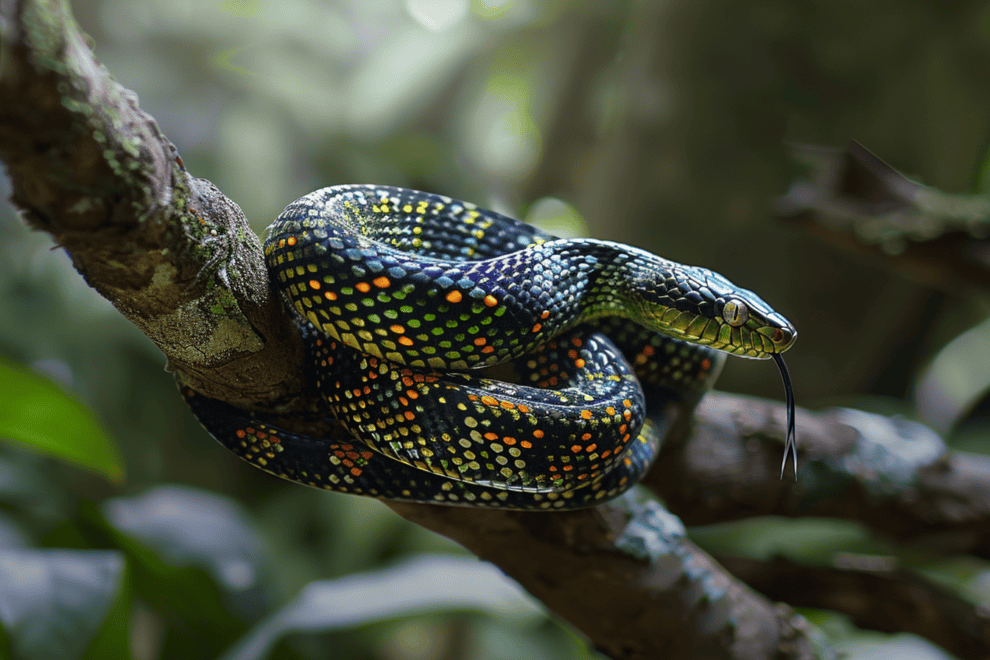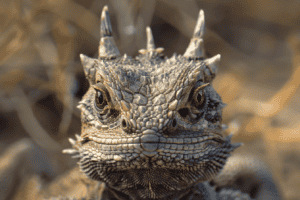Chrysopelea snakes are known for their remarkable ability to glide through the air, defying the laws of physics and leaving many people in awe.
Despite lacking wings or any other obvious means of flight, Chrysopelea snakes are able to glide through the air for impressive distances, sometimes even turning in mid-air.
This is achieved through a combination of specialized anatomy and unique movements that allow the snake to generate lift and control its trajectory.

Researchers have been studying these snakes for years in an effort to better understand the mechanics of their flight.
One particular species of Chrysopelea snake, the paradise flying snake, has garnered a lot of attention in recent years due to its impressive aerial abilities.
Researchers at Virginia Tech have even developed an anatomically accurate 3-D mathematical model of the snake to better understand how it launches itself from great heights and undulates its body to glide through the air.
As more is learned about these incredible creatures, the more we can appreciate the wonders of the natural world and the amazing adaptations that have evolved over time.
The Marvel of Chrysopelea: Nature’s Aerial Acrobats
Have you ever imagined a snake flying through the air? Well, the Chrysopelea snakes, also known as flying snakes, can glide through the air, and it’s a sight to behold.
These species of snakes are found in Southeast Asia and are known for their aerodynamic abilities.
The Chrysopelea snakes are part of the genus Chrysopelea, which consists of five species. The paradise tree snake, also known as Chrysopelea paradisi, is the most famous of them all.
These snakes are not only excellent climbers and swimmers, but they can also glide through the air with ease.
But how do they do it?
Scientists have been studying these amazing creatures for years, and they have finally unraveled the mystery of snake flight.
Chrysopelea snakes use a unique method called aerial undulation to glide through the air. This undulation is similar to the movement of a wave, which allows the snake to maintain stability while in the air.
The Science Behind the Gliding Phenomenon
The aerial undulation technique used by Chrysopelea snakes is a marvel of nature.
When they jump from a tree, they flatten their bodies, forming a concave shape that enables them to generate lift.
As they glide through the air, they undulate their bodies in a wave-like motion, which helps them maintain stability and direction.
Recent studies have shown that the undulation movement is similar to the spin of a frisbee. This movement helps the snake maintain its balance and direction while gliding through the air.
The Chrysopelea snakes can glide up to 100 meters, which is quite impressive for a limbless animal.
The Chrysopelea snakes’ gliding abilities are not only fascinating but also crucial for their survival.
These snakes use their gliding abilities to escape predators, reach new hunting grounds, and even mate.
Their unique abilities have also inspired engineers and scientists to study them for potential applications in robotics and aviation.
How Chrysopelea Snakes Harness the Air

Chrysopelea snakes, also known as flying snakes, are fascinating creatures that can glide through the air for distances up to 100 meters.
Their unique ability to fly without wings has puzzled scientists for years. Recent studies have revealed that these snakes use a combination of aerodynamic forces and biomechanics to stay airborne.
The snake’s body shape plays a vital role in its flight.
When the snake jumps from a tree, it flattens its body into a glider-like shape, similar to a parachute. This shape increases the surface area of its body, allowing it to generate lift and glide through the air.
The snake’s body also has a unique feature known as the “morphing wing.” This feature allows the snake to produce lift and drag when the air flows over its body.
During flight, the snake uses its undulation or aerial undulation to stabilize its body and adjust its flight path.
This undulation is a wave-like motion that travels down the length of the snake’s body, similar to the movement of a fish swimming in water. The undulation helps the snake to maintain dynamic stability and control its speed and direction.
From Tree Tops to the Ground: The Flight Path
Chrysopelea snakes use a unique method of aerial locomotion.
They jump from tree branches, flatten their bodies, and undulate through the air to produce a glide.
During the glide, the snake’s body curves in an S-shape, which generates extra boosts of power. At this angle, small vortices or whirlwinds of air generated around the snake give it added suction. Flying snakes get an extra boost of lift when facing the airflow at a certain angle.
The snake’s gliding flight path is affected by various factors such as its body shape, the angle of its glide, and the airflow around it.
Scientists have used 3D modeling and fluid mechanics to understand the aerodynamic forces at play during the snake’s flight.
They found that the snake’s gliding flight path is similar to that of birds and bats, but with a unique twist.
The Life of Chrysopelea: Beyond the Glide

Chrysopelea snakes, commonly known as flying snakes, are a genus of colubridae family that inhabit the forests, jungles, and woodlands of Southeast Asia.
They can be found in countries such as China, India, the Philippines, the Lesser Sundas, Maluku, and other regions with tropical climates.
These snakes are mildly venomous and have a cylindrical shape that allows them to move through narrow spaces and climb trees with ease.
Flying snakes are known for their unique ability to glide through the air, but they spend most of their time on trees.
They are arboreal, which means they live in trees, and they are excellent climbers. They use lateral undulation, a type of movement where they undulate their bodies from side to side, to climb trees and move around on branches. They are also known to swim in rivers and ponds when they need to cross water bodies.
Predators and Prey: Survival Among the Treetops
Flying snakes are preyed upon by a variety of predators, including birds of prey, larger snakes, and mammals.
To avoid being caught, they have developed several adaptations that allow them to blend in with their surroundings and escape quickly.
They are excellent at camouflage, and their coloration varies depending on their habitat.
For example, the golden tree snake has a sandy color that matches the color of the tree bark, while the paradise tree snake has green and black stripes that blend in with the leaves.
Flying snakes are carnivorous and feed on a variety of prey, including lizards, frogs, and small mammals.
They are ambush predators and wait patiently for their prey to come within striking distance.
Once they have spotted their prey, they launch themselves from the tree branch and glide towards their target. They can change their trajectories mid-air and make sharp turns, making them highly maneuverable.
Scientists have studied the glide performance of flying snakes and found that they can glide up to 100 meters in distance.
Their ability to glide has inspired bio-inspired robotics and has potential applications in designing robots that can navigate through different terrains.
Frequently Asked Questions
What’s the secret behind the flight of Chrysopelea snakes?
Chrysopelea snakes, also known as flying snakes, have a unique way of gliding through the air.
They don’t have wings or any other appendages to help them fly. Instead, they use their bodies to create an S-shape that allows them to glide through the air.
The snake flattens its body and undulates from side to side, creating a wave-like motion that generates lift and allows it to soar through the air.
Can you guess how these slithering creatures manage to glide through the air?
The secret to the flying snake’s ability to glide through the air lies in its unique body shape and movement.
The snake’s body is long, slender, and flexible, which allows it to create an S-shape that generates lift.
The snake undulates its body from side to side, creating a wave-like motion that propels it through the air. This unique movement allows the snake to glide through the air for distances of up to 100 meters.
Ever wondered if the flying snake is as dangerous as its ground-dwelling cousins?
Flying snakes are not venomous and are not considered dangerous to humans.
They are shy and elusive creatures that prefer to stay hidden in the treetops.
Flying snakes are not aggressive and will only bite if they feel threatened or cornered. However, it’s important to respect their space and avoid handling them, as they are wild animals and can become stressed or agitated if handled.
Curious about how far these aerial acrobats can soar between trees?
Flying snakes are capable of gliding through the air for distances of up to 100 meters. They use their unique body shape and movement to generate lift and control their flight path.
Flying snakes are most commonly found in Southeast Asia. There, they live in the treetops and use their gliding ability to move from tree to tree in search of food and mates.
What’s the truth behind snakes with wings – myth or reality?
Contrary to popular belief, there are no snakes with wings. The term “flying snake” is a misnomer, as these creatures do not actually fly. Instead, they glide through the air using a unique combination of body shape and movement.
While they may appear to have wings, they are simply using their bodies to create lift and control their flight path.
Have you seen the incredible footage of flying snakes in action?
There are many videos and images of flying snakes in action available online.
These incredible creatures are truly a sight to behold. Their unique body shape and movement allow them to glide through the air with ease.
Watching a flying snake in action is a true testament to the wonders of the natural world. It shows the incredible adaptations that animals have evolved to survive and thrive in their environments.









